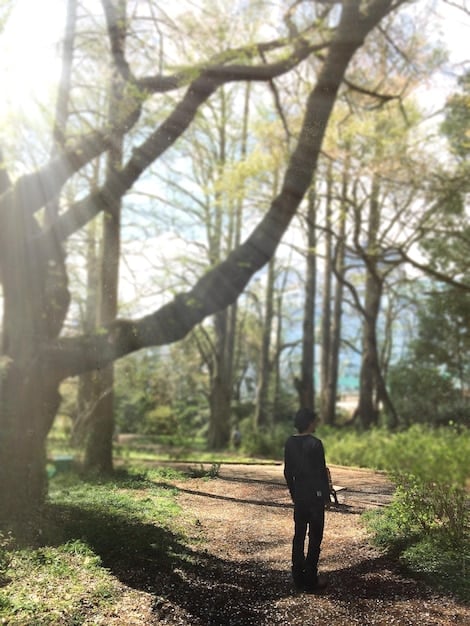Nature and Mental Health: Benefits of Outdoors in the US

Spending time outdoors in nature offers profound mental health benefits, impacting stress reduction, mood improvement, and cognitive function across diverse populations in the United States.
In a fast-paced world, the simple act of stepping outside can be a powerful balm for the mind. Exploring the benefits of nature: how spending time outdoors improves mental health in the US reveals a profound connection between green spaces and psychological well-being, offering tangible advantages for a healthier, happier life.
The Science Behind Green Spaces and Mental Wellness
The concept that nature can heal is ancient, but modern science now provides compelling evidence. Research from fields like environmental psychology and neuroscience illuminates how exposure to natural environments positively impacts our brains and bodies, leading to measurable improvements in mental health. It’s not just a feeling; it’s a physiological response.
Our nervous systems are intricately linked to our surroundings. Urban environments, often characterized by noise, concrete, and constant stimulation, can trigger stress responses. Conversely, natural settings tend to induce a state of calm and focused attention, reducing the physiological markers of stress.
Stress Reduction and Cortisol Levels
One of the most well-documented benefits of nature exposure is its ability to lower stress. Studies show that spending time in natural environments, even for short periods, can significantly decrease cortisol levels, the primary stress hormone. This reduction in physiological stress translates to a calmer state of mind.
- Cortisol Decrease: Natural settings lead to a measurable drop in stress hormones.
- Heart Rate Variance: Improved heart rate variability, indicating better stress coping.
- Blood Pressure Regulation: A noticeable reduction in elevated blood pressure.
This biological response is fundamental to understanding why a walk in the park can feel so restorative. It allows the body to shift from a “fight or flight” state to a “rest and digest” mode, essential for long-term health and well-being. The sounds, sights, and even smells of nature contribute to this calming effect, creating a multi-sensory therapeutic experience.
Beyond the immediate physiological changes, continued engagement with nature can build resilience against future stressors. Regular exposure helps train the body to better manage stress responses, leading to more sustained mental health benefits over time. It’s a cumulative effect, much like building physical strength through consistent exercise.
Enhancing Mood and Emotional Well-being
Beyond stress reduction, nature has a remarkable capacity to uplift spirits and foster positive emotions. The vibrant colors of a sunset, the gentle rustle of leaves, or the expanse of a natural landscape can evoke feelings of awe, gratitude, and tranquility. These emotional shifts contribute significantly to overall emotional well-being.
Research suggests that time spent in nature can alleviate symptoms of depression and anxiety. This isn’t to say nature is a standalone cure, but it serves as a powerful complementary therapy, offering a gentle yet effective way to improve mood and emotional regulation. It provides a sense of perspective and connection often lost in urban living.
Combating Symptoms of Depression and Anxiety
A growing body of evidence indicates that engaging with nature can be a vital component in managing mental health conditions. Simply being present in a natural environment can act as a natural antidepressant, stimulating brain regions associated with happiness and reducing rumination.
- Reduced Rumination: Nature helps break negative thought cycles.
- Increased Positive Affect: Fosters feelings of happiness and contentment.
- Symptom Alleviation: Can lessen the severity of depressive and anxious symptoms.
The act of moving outdoors, even for a short stroll, introduces physical activity, which is itself a known mood booster. Combined with the sensory input from nature, this creates a potent synergy for improving emotional states. The sunlight also plays a role, helping regulate our circadian rhythms and boosting vitamin D levels, both linked to mood regulation.
Moreover, natural settings often encourage mindfulness and presence. When surrounded by nature, individuals are more likely to focus on the immediate sensory experience rather than getting caught up in worries about the past or future. This heightened state of awareness can be incredibly therapeutic, grounding us in the present moment.

Cognitive Benefits and Improved Focus
In an age of constant digital distraction, our attention spans often feel fragmented. Nature offers a unique antidote to this modern challenge by providing restorative environments that enhance cognitive function, particularly directed attention. This ability to focus intently is crucial for productivity, learning, and daily functioning.
The “Attention Restoration Theory” (ART) posits that natural environments allow our “directed attention” to rest and recover. Unlike urban environments that demand constant directed attention (e.g., navigating traffic, processing information overload), nature provides “soft fascination”—stimuli that capture our attention effortlessly, allowing our directed attention to replenish.
Boosting Concentration and Creativity
Studies have shown that spending time in natural settings can lead to improvements in memory, problem-solving skills, and creative thinking. This cognitive boost is particularly valuable for students, professionals, and anyone seeking to enhance their mental acuity.
- Enhanced Focus: Improved ability to concentrate on tasks.
- Problem-Solving Skills: Better imaginative solutions to challenges.
- Creativity Boost: Increased divergent thinking and novel ideas.
Even a brief glance out of a window at a green space has been linked to better performance on cognitive tasks. This suggests that access to nature, even passively, can have significant benefits for our brain health. For children, particularly those with ADHD, outdoor time has been shown to reduce symptoms and improve attention.
Furthermore, the quietude often found in natural settings allows for a reduction in cognitive load. When the brain isn’t constantly processing overwhelming stimuli, it has more capacity to organize thoughts, consolidate memories, and engage in deeper levels of reflection. This mental spaciousness is a prerequisite for creative breakthroughs.
The Role of Nature in Physical Activity and Social Connection
While the mental benefits are paramount, time spent outdoors inherently encourages physical activity, which in turn has profound positive impacts on mental health. Nature provides the ideal backdrop for exercise, from gentle walks to vigorous hikes, making it a more appealing and sustainable habit for many.
Beyond individual engagement, outdoor spaces often serve as vital hubs for social interaction. Parks, trails, and community gardens foster a sense of belonging and provide opportunities for people to connect, addressing the growing concern of social isolation, which is a significant determinant of mental well-being.
Encouraging Physical Activity
The mental benefits of exercise are well-established, including reducing symptoms of depression and anxiety, improving sleep, and boosting self-esteem. Nature provides motivation, making exercise feel less like a chore and more like an enjoyable experience. The varied terrain and fresh air contribute to a more stimulating workout.
- Increased Motivation: Nature provides an appealing backdrop for exercise.
- Enhanced Mood During Exercise: “Green exercise” often feels more enjoyable.
- Improved Sleep Quality: Outdoor activity can regulate sleep cycles.
Whether it’s walking through a local park, cycling along a scenic trail, or engaging in outdoor sports, the natural environment makes physical activity more accessible and enjoyable. This increased adherence to exercise routines directly contributes to better mental health outcomes, creating a virtuous cycle.
Moreover, sunlight exposure during outdoor physical activity aids in Vitamin D synthesis, which is crucial not only for bone health but also for mood regulation and reducing the risk of seasonal affective disorder (SAD). The combination of movement and natural light amplifies the therapeutic effects.
Fostering Community and Reducing Isolation
Public green spaces are crucial for community building. They provide informal gathering places where people can meet, socialize, and participate in shared activities. This sense of community and connection is a powerful antidote to loneliness, which has been identified as a significant public health concern.
From community gardening projects to organized group walks, nature facilitates social bonds. These interactions provide opportunities for emotional support, shared experiences, and a sense of belonging, all of which are vital for robust mental health. The shared appreciation of nature itself can be a bonding experience.
For many, participating in outdoor groups or clubs centered around activities like hiking, birdwatching, or photography provides structured opportunities to meet like-minded individuals. This integration into social networks reinforces mental well-being and offers a sense of purpose and collective identity.
Accessibility and Equity in Nature’s Healing Power
While the benefits of nature are universal, access to green spaces is not. Disparities in urban planning and resource allocation mean that some communities, particularly those in underserved areas, have limited access to parks, trails, and other natural amenities. Addressing these inequities is crucial for promoting mental health across all populations.
Ensuring that every American, regardless of their socioeconomic status or zip code, has reasonable access to nature is not just an environmental issue; it’s a public health imperative. Initiatives focused on creating and maintaining urban green spaces, community gardens, and accessible natural parks are vital steps towards this goal.
Bridging the Nature Access Gap
Advocacy for environmental justice plays a critical role in ensuring equitable access. This involves not only creating new green spaces but also improving existing ones and ensuring they are safe, well-maintained, and welcoming to all members of the community.
- Urban Greening Projects: Developing parks and green corridors in underserved areas.
- Community Gardens: Creating shared spaces for growing food and fostering connection.
- Accessible Transportation: Ensuring public transport options to natural areas.
Policies that prioritize green infrastructure in urban development can make a significant difference. This includes integrating natural elements into city designs, such as tree-lined streets, pocket parks, and green roofs. Such initiatives not only improve mental health but also contribute to healthier, more sustainable cities overall.
Education and outreach programs can also help connect people, particularly those less familiar with outdoor activities, to nearby natural resources. Promoting nature-based therapy and encouraging healthcare providers to “prescribe” time in nature are innovative approaches gaining traction, highlighting the therapeutic potential of green spaces.

Practical Ways to Incorporate Nature into Daily Life
Integrating nature into daily routines doesn’t necessarily require a wilderness expedition. Even small, consistent interactions with the natural world can yield significant mental health benefits. The key is intentionality and finding what works best for individual circumstances and preferences.
From city dwellers to suburban residents, there are myriad ways to invite more green into life. It’s about recognizing and seizing the opportunities around us, transforming passive exposure into active engagement with the natural environment.
Simple Strategies for Urban Dwellers
Even within a bustling city, opportunities abound. Exploring local parks, walking tree-lined streets, or tending to indoor plants can make a difference. The goal is to consciously seek out and appreciate natural elements.
- Park Walks: Regular visits to local parks for strolls or quiet contemplation.
- Balcony Gardens: Creating a green haven in small outdoor spaces.
- Mindful Observation: Noticing clouds, birds, or changing seasons from a window.
For those with limited outdoor access, bringing nature indoors can also be beneficial. Houseplants have been shown to improve mood and reduce stress. Nature documentaries and virtual reality experiences that simulate natural environments can also offer a psychological uplift, though they are not a substitute for direct experience.
Consider integrating short “nature breaks” into your workday. A quick walk around the block, a few minutes spent near a window with a view, or even listening to nature sounds can help clear the mind and refresh focus. These micro-breaks can accumulate significant benefits over time, reducing mental fatigue.
Embracing Outdoor Activities
For those with greater access, engaging in more immersive outdoor activities can deepen the connection with nature and amplify its benefits. This can range from casual walks to more adventurous pursuits, always prioritizing safety and enjoyment.
Hiking, camping, gardening, birdwatching, or simply picnicking in a scenic spot are all ways to actively engage with the natural world. These activities provide opportunities for physical exercise, mental restoration, and often, social connection. The variety ensures that there’s an outdoor pursuit for almost everyone.
Joining outdoor recreation groups or volunteering for conservation projects can enhance the experience by adding a social dimension and a sense of purpose. Contributing to the preservation of natural spaces can be incredibly rewarding and reinforce the positive feedback loop between nature and well-being.
Ultimately, the best approach is one that fits individual lifestyles and comfort levels. The paramount aspect is to cultivate a conscious relationship with nature, recognizing its power to soothe, inspire, and heal the mind. Even small steps taken consistently can lead to significant improvements in mental health.
| Key Benefit | Brief Description |
|---|---|
| 🧘 Stress Reduction | Lowers cortisol levels and promotes relaxation. |
| 😊 Mood Enhancement | Alleviates symptoms of depression and anxiety, fostering positive emotions. |
| 🧠 Cognitive Boost | Improves focus, concentration, and creative problem-solving. |
| 🏃♂️ Physical & Social | Encourages activity and fosters community connections. |
Frequently Asked Questions
▼
While any amount of time helps, studies suggest that at least 120 minutes per week, or about 20 minutes a day, can significantly improve mental health. This time doesn’t have to be continuous and can be accumulated in shorter bursts throughout the week.
▼
Yes, even small urban green spaces like parks, community gardens, and tree-lined streets offer significant mental health benefits. While wilderness provides unique experiences, accessible urban nature can still reduce stress, improve mood, and enhance cognitive function for city dwellers.
▼
Nature exposure has been shown to help alleviate symptoms of depression, anxiety, and stress. It can also improve aspects of ADHD, reduce rumination, and enhance overall emotional well-being. It serves as a valuable complementary approach to traditional therapies.
▼
Generally, spending time in nature is highly beneficial. However, it’s essential to consider personal safety, weather conditions, and potential allergens. Ensure you are aware of your surroundings, wear appropriate clothing, and inform others of your whereabouts if exploring remote areas.
▼
Even in cities, you can visit local parks, walk through tree-lined neighborhoods, try urban gardening, or bring houseplants indoors. Observing the sky, listening to nature sounds, or taking short breaks near natural elements can also provide valuable mental benefits.
Conclusion
The profound mental health benefits of spending time outdoors are no longer anecdotal—they are supported by a rapidly expanding body of scientific evidence. From reducing stress and improving mood to boosting cognitive function and fostering social connection, nature offers a powerful, accessible, and often overlooked remedy for the challenges of modern life. In the United States, prioritizing access to and engagement with natural spaces is not just an environmental luxury but a vital component of public health and individual well-being. Embracing nature, in all its forms, is an investment in a healthier, happier mind.





